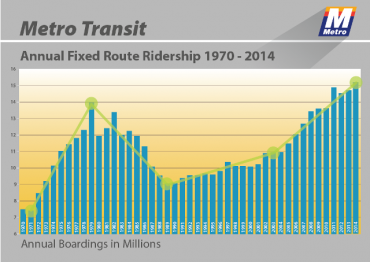Metro Transit Sets Another All-Time Ridership Record in 2014
More than 15 million rides were taken on Metro Transit in 2014, an all-time ridership record.
Metro recorded more than 15.2 million rides last year, compared to 14.7 million rides in 2013. This ridership is the first time Metro has tallied more than 15 million rides in a single year.
This increase compares to a slightly decreasing trend in bus ridership on a national level.
According to third quarter numbers released by The American Public Transportation Association (APTA), bus ridership decreased nationally by an average of 0.4 percent. End of year national ridership levels are not yet available.
Metro Transit’s continued increase in ridership can be attributed to a number of factors, explained Metro Transit General Manager Chuck Kamp. One of the main reasons we’re seeing is the increase use of smartphones which makes using the bus easier than ever.
In 2012, Metro began partnering with third party developers to provide smartphone apps that give customers live bus arrival estimates to individual bus stops.
“These apps have made bus-riding easier and more efficient,” Kamp said. “In addition, using mass transit for your commute provides a 25th hour to your day. You can get on the bus and use your mobile device to catch up on emails, read the news, or get an early start or late finish to your workday.”
Metro also continues to discover that Millennials are more interested in utilizing mass transit than purchasing a car.
According to a 2014 report Millennials in Motion released by the U.S. Public Interest Research Group (U.S. PIRG), the Millennial generation is less car-focused than older Americans and previous generations of young people. Young Americans drive less and use public transportation more. Madison is the type of community that young people want to move to, and having a good transit system is becoming a key economic development tool.
However, with this success, also comes challenges.
Metro’s two largest number of passenger complaints are buses being overcrowded and that buses have trouble maintaining their schedules.
In 2013, a transit study was completed that examined the possibility of implementing a Bus Rapid Transit System (BRT) in the Madison area. A bus rapid transit (BRT) is a high-frequency limited-stop transit system that offers faster more direct service using larger vehicles to increase capacity. This study was undertaken to identify ways to alleviate overcrowded buses, reduce travel times, and meet a goal set by the City of Madison Mayor Paul Soglin to double ridership in the next 10 to 20 years.
In 2014, a bus size study was completed that examined the efficiency and effectiveness of Metro’s vehicle size. This study specifically recommended the purchase of 40 larger articulated buses to help address these schedule and capacity problems.
On February 3 of this year, the City of Madison Common Council voted to accept the 2013-2017 Transit Development Plan for the Madison Urban Area which recommended that a BRT could help the City achieve its long-term strategic transportation planning and urban development goals. As part of this vote, the Council authorized Metro to move forward on next phases of development, environmental evaluation, and project implementation of this type of system.
Due to drops in federal funding, Metro Transit staff are concerned there will not be enough resources necessary to invest in a BRT.
Metro is also in need of additional funding to undertake the construction of a much-needed bus garage.
Metro currently houses 214 full-sized buses and 17 paratransit vehicles in a garage designed to only hold 160 vehicles. Even if funding were available to purchase extra buses, Metro currently does not have the space to store them.
Metro representatives have met with federal and state legislators to discuss its increased need for funding to grow the transit infrastructure in the Madison area. Additionally, Metro is seeking the approval of a potential regional transit authority in Wisconsin, which would further provide the funding and governance structures needed to better serve the increasing transit needs of the community.
“These are exciting times and we look forward to the challenges ahead,” Kamp said. “Though, at this point, we need to celebrate and recognize our safe and dedicated drivers, maintenance staff, customer service representatives and all other Metro employees whose contributions have helped get us to the level we are at today.
“And most importantly, we want to recognize our passengers, oversight committee members, legislators, and everyone else that has supported Metro through the years. It is only with this strong and sustained support that Metro is able to achieve this type of success.”
Contacts
- Mick Rusch , 608-266-4904, mrusch@cityofmadison.com
